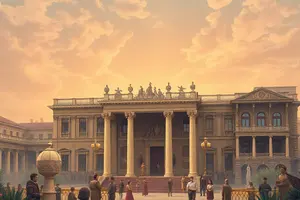Podcast
Questions and Answers
What is the definition of government in the context of Roman achievements?
What is the definition of government in the context of Roman achievements?
Three branches of government, two elected officials, free citizens can vote.
What is an aqueduct?
What is an aqueduct?
A human-made canal that runs water from city to city.
How is ancient Roman architecture characterized?
How is ancient Roman architecture characterized?
Adopted the external language of classical Greek architecture and resulted in a new architectural style.
What was the size of the Roman Empire?
What was the size of the Roman Empire?
What advancements did Roman engineering contribute to?
What advancements did Roman engineering contribute to?
What is the Colosseum?
What is the Colosseum?
What class of citizenship was granted in Rome?
What class of citizenship was granted in Rome?
What is Byzantine art?
What is Byzantine art?
What was the status of Christianity in the West after Constantine's death?
What was the status of Christianity in the West after Constantine's death?
What was the religion of the Byzantine Empire?
What was the religion of the Byzantine Empire?
When did the Western Roman Empire fall?
When did the Western Roman Empire fall?
When did the Byzantine Empire fall?
When did the Byzantine Empire fall?
What is the Justinian Code?
What is the Justinian Code?
What language became dominant during the Roman Republic?
What language became dominant during the Roman Republic?
Flashcards are hidden until you start studying
Study Notes
Government
- Roman government featured three branches: executive, legislative, and judicial.
- Two elected officials were prominent, enhancing democratic processes.
- Voting rights were extended to free citizens, reflecting a level of civic engagement.
Aqueducts
- Aqueducts are engineered canals designed to transport water across cities.
- Demonstrated advanced Roman engineering and urban planning.
Architecture
- Ancient Roman architecture drew heavily from classical Greek styles, yet evolved into its unique form.
- The blend of these styles is recognized as a significant development in classical architecture.
Empire Size
- The Roman Empire covered approximately 1.699 million square miles, showcasing its vast territorial expansion.
Engineering
- Roman engineering is noted for remarkable constructions like roads, theaters, and baths, many of which endure today.
- Innovations improved daily living, including reliable water supply systems.
Colosseum
- The Colosseum, or Flavian Amphitheatre, is located in Rome and is the largest amphitheater ever constructed.
- It was built using concrete and sand, symbolizing Roman architectural prowess.
Citizenship
- Roman citizenship included a class system with limited rights for certain groups.
- Freed slaves received citizenship, while Peregrini (foreigners in conquered territories) could acquire full or partial rights.
Byzantine Art
- Byzantine art encompasses the artistic heritage of the Eastern Roman (Byzantine) Empire and its cultural successors.
Christianity in the West
- After the death of Emperor Constantine, Christianity was established as the official religion of the Roman Empire.
Christianity in the Byzantine Empire
- The Byzantine Empire was predominantly Orthodox Christian, influencing the religious landscape within Ottoman territories.
Fall of the West
- The Western Roman Empire fell in 476 AD, largely due to barbarian invasions, marking a significant historical transition.
Fall of the Byzantine Empire
- The Byzantine Empire fell on May 29, 1453, after an Ottoman siege on Constantinople, leading to the death of Emperor Constantine XI and the empire's demise.
Justinian Code
- The Justinian Code organized and codified existing Roman laws, impacting legal systems in the future.
Latin Language
- Latin became the dominant language of the Roman Republic and subsequently influenced several modern languages, including Italian, Portuguese, Spanish, French, and Romanian.
Studying That Suits You
Use AI to generate personalized quizzes and flashcards to suit your learning preferences.




